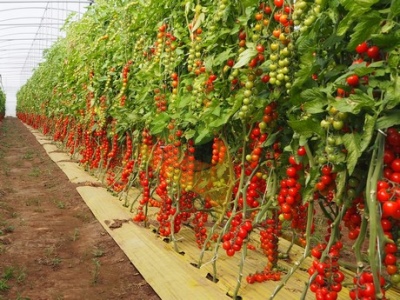
- Authors: Italy
- Name synonyms: Porpora
- Category: hybrid
- Growth type: indeterminate
- Appointment: fresh consumption, for pickling and preserving, for drying and drying
- Ripening period: early
- Ripening time, days: 103-115
- Growing conditions: for open ground, for film greenhouses
- Transportability: high
- Bush size: tall
Tomatoes are an indispensable vegetable on our table throughout the year. It seems that there is no summer resident who would not grow tomatoes in order to stock up on conservation for the winter. Knowledge of the correct care of the Porpora variety helps to harvest a high-quality and generous harvest.
Description of the variety
This hybrid variety is of the indeterminate type. These are tall shrubs that grow compact with strong foliage.
Tomatoes of this type are suitable not only for fresh consumption, but also for preservation and even drying. They are highly portable.
The main qualities of the fruit
Porpora fruits are spherical, red-purple, weighing only 25 grams. This variety belongs to the cherry type. Up to 15 tomatoes are formed in one brush. Importantly, tomatoes of the described variety can be stored for a long time.
Taste characteristics
Porpora tomatoes taste sweet.
Ripening and fruiting
The fruits ripen early, in just 103-115 days.
Yield
This indicator is assessed as high.
The timing of planting seedlings and planting in the ground
When the seedlings are 45-50 days old, they can be planted in the ground.

Growing tomato seedlings is an extremely important process, because it largely depends on whether the gardener will be able to harvest at all. All aspects must be taken into account, from seedbed preparation to planting in the ground.
Landing scheme
It is best to use a 40 * 60 cm scheme.

Growing and care
A common question is whether it is necessary to soak seeds for prevention from various diseases before planting. Purchased - no, because they have already been processed. Unless, if you wish, you can soak the Porpoor tomatoes for seedlings in the Gulliver Stimul growth stimulator. It contains natural phytohormones and potassium humate, which will nourish tomatoes for a long time.
If the seed was collected independently from its own garden, then an infection from the soil may remain on it. In this case, the future seedlings of Porpora can get sick with late blight and black leg. These are fungal diseases that develop with excessive watering and thickening of the seedlings.
For disinfection, dissolve 1 g of potassium permanganate (potassium permanganate) in 100 ml of water to obtain a 1% solution. Soak the seed for 10-15 minutes. After such a bath, it must be rinsed with clean water.
You can use the drug "AC-Selective" for the treatment of seed, it helps against a complex of diseases and pests. To do this, take 10 ml of the drug per 1 liter of water and soak the seeds for 1 hour, without rinsing after that.
The Porpora variety requires shaping, 1 or 2 stems remain after processing.
Good prevention of calcium deficiency in Porpora is the introduction of ash during digging and as spraying on the leaves. It will not be superfluous to pour a glass of ash into the hole when planting seedlings in open ground.
If you suspect the beginning of calcium starvation, spray the plants with mineral fertilizer. Dissolve 10-15 g of calcium nitrate in 10 liters of water and water the tomato leaves every 7 days. You can also pour 2 liters under the root, while watering the plant beforehand. In addition, a good result is given by feeding on leaves with calcium chloride - 30-40 g per 10 liters of water.




A plant needs different micronutrients at each stage of growth. All fertilizers can be divided into two groups: mineral and organic. Folk remedies are often used: iodine, yeast, bird droppings, eggshells.
It is important to observe the rate and period of feeding. This also applies to folk remedies and organic fertilizers.
Disease and pest resistance
The described variety has resistance to some diseases:
- spotted wilting;
- tobacco mosaic;
- fusarium wilting.
If the top of the Porpora tomato turns black, it means that a fungus has been added to the top rot. It is advised to treat all the bushes on the site with a prophylactic drug - for example, "Healer" or "Protection". They will not cure apical rot because it is a metabolic problem, but they will prevent fungal diseases from spreading to other plants in the garden.
There are many folk remedies for combating top rot, which consist in introducing calcium into the soil. In particular, it is advised to crush the eggshells into powder and sprinkle tomatoes between the rows. The application of fertilizers with calcium will give a greater effect. It is better to use dolomite flour, which also saturates the soil with magnesium and reduces the acidity of the soil (thereby reducing the number of weeds and pests). The more acidic the soil, the more flour is added - 35-50 kg per hundred square meters, better during autumn digging.


Resistant to adverse weather conditions
Porpora withstands heat and cold very well.

























































































